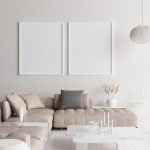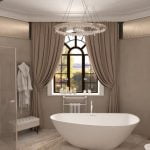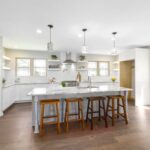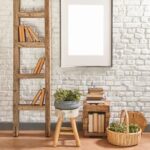Are you looking to revamp your home decor but not sure where to start? One of the best ways to gather inspiration, refine your style, and visualize your design ideas is by creating a mood board. In this article, we’ll guide you on how to make a home decor mood board that will help bring your interior design dreams into reality.
A home decor mood board is a visual tool used to communicate and organize ideas for a design project. It typically consists of images, fabric swatches, paint chips, and other material samples arranged on a board or digitally. This allows you to see how different elements work together and can help ensure that the final result matches your vision.
Creating a mood board is an essential step in the interior design process as it serves as a roadmap for your project. It provides clarity and direction, helping you stay focused on the overall look and feel you want to achieve in your home. Whether you’re renovating an entire room or simply updating the decor in one area, a mood board can be an invaluable tool in bringing your design ideas to life.
Gathering Inspiration
When creating a home decor mood board, the first step is to gather inspiration from various sources. This process involves finding ideas, themes, and concepts that will serve as the foundation for your mood board. Here are some tips for finding inspiration for your home decor mood board.
Utilize Online Platforms
One of the best ways to gather inspiration for your home decor mood board is by utilizing online platforms such as Pinterest, Instagram, and interior design websites. These platforms are filled with countless images and ideas that can help spark your creativity. Create a digital mood board by saving images and creating virtual collages to capture the aesthetic you’re aiming for.
Visit Home Decor Stores
Another great way to find inspiration for your mood board is by visiting home decor stores in person. Take a trip to furniture stores, fabric shops, or even art galleries to get a hands-on look at different materials and styles. You can take photos of items that catch your eye or collect fabric swatches to add to your physical mood board.
Look at Design Books and Magazines
Design books and magazines are fantastic resources for gathering inspiration for your mood board. Whether it’s a coffee table book on interior design or a subscription to a home decor magazine, these printed materials often feature beautifully curated images and design ideas that can help guide the concept of your mood board.
By using these tips to gather inspiration, you’ll have an array of ideas to choose from when creating your home decor mood board. Whether you’re browsing online platforms, visiting stores in person, or flipping through magazines, there are endless possibilities for finding the perfect elements to bring your vision to life.
Choosing a Theme
When it comes to creating a home decor mood board, the first step is to choose a theme or style for your design. Selecting a cohesive concept will help guide the entire process and ensure that your home decor is visually appealing and harmonious. Here are some tips for choosing the perfect theme for your mood board:
Reflect Your Personal Style
Before you begin gathering inspiration, take some time to think about your personal style and preferences. Consider what colors, patterns, and textures appeal to you, as well as any specific themes or motifs that you love. Whether you prefer a minimalist Scandinavian aesthetic or a cozy farmhouse vibe, it’s important to choose a theme that reflects your unique tastes and personality.
Consider Your Space
Another important factor to consider when choosing a theme for your home decor mood board is the specific space you are decorating. Take into account the architectural features of the room, its natural lighting, and its overall purpose. For example, a serene coastal theme might be perfect for a bedroom or living room, while a sleek modern look could work well in an office or kitchen.
Research and Explore
Once you have an idea of your personal style and the requirements of your space, it’s time to start researching and exploring different themes. Look for inspiration in interior design magazines, online blogs, social media platforms like Pinterest and Instagram, and even in real-life spaces such as hotels or restaurants. Pay attention to color palettes, furniture styles, decorative elements, and overall atmospheres that resonate with you.
By following these tips for choosing a theme for your home decor mood board, you can ensure that your design concept is cohesive, personal, and tailored to the specific needs of your space. Ultimately, selecting the right theme will set the foundation for creating a beautiful and harmonious home decor scheme that brings joy and comfort to your living environment.
Selecting Materials
When it comes to creating a home decor mood board, selecting the right images, fabrics, and samples is crucial in accurately representing the style and concept you’re trying to achieve. Whether you’re designing a mood board for a specific room or for your entire home, the materials you choose will set the tone for the overall aesthetic. Here are some tips on how to choose the right materials for your home decor mood board.
First, consider the color scheme and overall theme of your design. If you’re going for a minimalistic look, opt for images and fabric swatches in neutral tones such as white, grey, or beige. For a more vibrant and eclectic theme, don’t be afraid to experiment with bold colors and patterns. The materials you select should reflect the mood and atmosphere you want to create in your space.
In addition to considering the visual aspect of your materials, also think about texture. Mixing different textures can add depth and interest to your mood board. Consider including samples of various fabrics, wallpapers, or even natural materials like wood or stone to bring tactile elements into your design. By incorporating a variety of textures into your mood board, you can create a more dynamic and multi-dimensional representation of your vision for your home decor.
| Material Type | Example |
|---|---|
| Fabric | Swatch of velvet upholstery fabric in deep emerald green |
| Image | Photograph of a coastal landscape with sandy beach and blue ocean |
| Sample | Cut-out piece of reclaimed wood flooring |
By carefully choosing the right images, fabrics, and samples for your home decor mood board, you can effectively communicate your design ideas and bring your vision to life within your space. This step is essential in creating a cohesive and visually appealing representation of what you want to achieve with your home decor.
Layout and Design
Creating a home decor mood board is a fun and creative way to plan out the design and style of your living space. Once you have gathered all the necessary inspiration and chosen a theme for your home decor, it’s time to organize your mood board for maximum impact.
The layout and design of your mood board can greatly affect how well it communicates your vision for your home, so here are some tips to help you organize it effectively.
One of the first things to consider when organizing your mood board is the overall composition. Think about how you want to arrange the images, fabrics, and samples on the board to create a cohesive and visually appealing display. Consider using different shapes and orientations for variety, but make sure that everything flows together smoothly.
In addition to composition, color plays a crucial role in the layout of your mood board. By carefully selecting and arranging colors that complement each other, you can create a harmonious and balanced aesthetic that truly showcases your vision for your home decor.
Pay attention to how different colors interact with each other and how they evoke certain moods or emotions. For example, warm tones like reds and yellows can create a cozy atmosphere, while cool tones like blues and greens can promote a sense of calmness.
Another important aspect of organizing your mood board is creating visual hierarchy. This involves arranging elements in such a way that certain items stand out more than others, drawing the viewer’s eye toward specific focal points. You can achieve this by varying the size, shape, or placement of different elements on the board. This will help guide viewers through the mood board in a deliberate manner, ensuring that they take in everything you want them to see.
| Layout Tips | Design Tips |
|---|---|
| Consider overall composition | Select colors that complement each other |
| Arrange elements for visual hierarchy | Vary size, shape, or placement of elements |
Bringing It to Life
Once you have gathered inspiration, chosen a theme, and selected materials for your home decor mood board, the next step is to bring it to life in your home. Here are some tips for turning your mood board into a reality:
1. Start with the foundation: The first step in bringing your mood board to life is to start with the foundational elements of your design. This could include painting or wallpapering the walls, choosing the right flooring, and selecting key furniture pieces that align with the overall style and concept of your mood board.
2. Layer in accessories: Once the foundation is set, it’s time to add in the smaller details and accessories that will really bring your mood board to life. This could include decorative accents like throw pillows, artwork, rugs, and other decorative elements that add personality and depth to your space.
3. Pay attention to lighting: Lighting can make a big impact on the look and feel of a room. Consider how different lighting options can enhance the mood and atmosphere of your space, whether it’s through natural light from windows, overhead lighting fixtures, or task lighting for specific areas.
By following these steps and considering every detail carefully, you can turn your home decor mood board into a beautiful reality in your home.
DIY vs Professional
When it comes to creating a home decor mood board, one of the first decisions you’ll need to make is whether to do it yourself or hire a professional designer. Both options have their pros and cons, so it’s important to carefully consider what will work best for your specific needs and budget.
If you choose to make your own mood board, you’ll have complete control over the creative process. You can gather inspiration from various sources, select materials that align with your vision, and design the layout in a way that speaks to your personal style. Additionally, making your own mood board can be a fun and rewarding DIY project that allows you to express your creativity.
On the other hand, hiring a professional designer can take the pressure off of you and ensure a cohesive and well-executed result. Designers have access to resources and industry knowledge that may not be readily available to the average homeowner, which can elevate the quality of your mood board. They also bring expertise in design principles and trends that could enhance the overall aesthetic of your home decor.
Another benefit of hiring a designer is the time-saving aspect. Creating a mood board from scratch can be time-consuming, especially if you’re not familiar with design tools or techniques. A professional designer will be able to streamline the process and bring your vision to life more efficiently. However, it’s important to weigh this against the potential cost of hiring a designer versus doing it yourself.
Conclusion
In conclusion, creating a home decor mood board is an essential step in the process of designing and decorating your living space. By gathering inspiration, choosing a theme, selecting materials, organizing the layout, and bringing it to life, you can effectively communicate your vision for your home decor. Whether you choose to DIY or hire a professional designer, a mood board serves as a valuable tool to help you visualize and execute your ideas.
When it comes to gathering inspiration for your mood board, don’t limit yourself to just home decor magazines or websites. Take a stroll through nature, visit local art exhibitions, or even draw from personal experiences and memories. The key is to find elements that resonate with you and reflect your personality and style. Additionally, when selecting materials for your mood board, consider incorporating various textures, colors, and patterns to create visual interest and depth.
As you bring your mood board to life in your home, remember that it’s okay to make adjustments along the way. Designing and decorating are processes that evolve over time, so be open to experimenting with different elements until the final result feels just right.
Whether you decide to tackle this project on your own or seek professional assistance, creating a home decor mood board is an exciting opportunity to showcase your creativity and make your living space truly feel like home.
Frequently Asked Questions
How Do You Make a Mood Board for a House?
Making a mood board for a house involves gathering inspiration images, color swatches, fabric samples, and any other elements that represent the desired aesthetic. These can be arranged on a physical or digital board to visualize the overall look and feel of the space.
How Do You Make an Interior Design Vision Board?
To create an interior design vision board, start by defining the design concept and collecting images, textures, patterns, and colors that embody this vision. Organize these elements on a board to create a cohesive representation of the desired interior style.
How Do I Make an Interior Design Mood Board Online?
Making an interior design mood board online can be done using various digital platforms and tools such as Canva, Adobe Spark, or Pinterest. These platforms allow you to easily gather and arrange images, textures, and colors to create a virtual mood board that can be shared with others for collaboration or feedback.

I’m thrilled to be your companion on this exciting journey through the world of home decor and design. With a passion for turning houses into homes and a keen eye for the finer details, I’m here to help you transform your living spaces into beautiful, functional, and meaningful havens.





